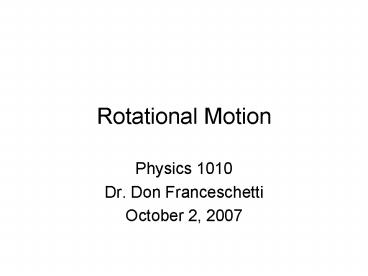Rotational Motion - PowerPoint PPT Presentation
1 / 21
Title:
Rotational Motion
Description:
What are the rotational analogues of mass, velocity, acceleration, force, momentum? ... So build your space station in the form of a donut and make it rotate. ... – PowerPoint PPT presentation
Number of Views:146
Avg rating:3.0/5.0
Title: Rotational Motion
1
Rotational Motion
- Physics 1010
- Dr. Don Franceschetti
- October 2, 2007
2
Rotational motion
- How does physics describe rotating bodies?
- What is centrifugal force
- What are the rotational analogues of mass,
velocity, acceleration, force, momentum? - Why are gymnasts small and ballet dancers skinny?
- How does running differ from walking?
3
Rotational Motion
- Wheels are very useful. But different parts of
the wheel have to be moving at different speeds.
(tangential speed) - We can describe the motion of the wheel as a
whole by its rotational speed (angular speed) in
revolutions per minute or radians per second.
4
Rotational Inertia
- An object rotating about an axis tends to remain
rotating about that axis unless interfered with
by some external torque. The property of an
object which describes its resistance to changes
in rotation is called its rotational inertia. - (Why dont the parts of the object move in a
straight line?) - Rotational inertia depends on the distribution of
mass around the axis.
5
Rotational Inertia
- Pendulum Imr2
- Hoop about normal axis Imr2
- Solid cylinder I(1/2)mr2
- Sphere about center I(2/5)mr2
6
Torque
- Is the rotational analog of force
- lever arm x force
- Where lever arm is perpendicular distance from
axis of rotation
7
Center of Mass
- Is the one point in an object that seems to move
like a point mass, - Sometimes called center of gravity
8
Locating the center of gravity
- Center of gravity is always below point of
support of object hanging freely. - Center of gravity must be above area of support
when supported from below. - Center of gravity need not be located in object
9
A note on composite bodies
- The human body is a composite body which can
change shape. - Center of mass of the body accelerates in
response to the gravitational and contact forces
acting on it. - When not in contact with other bodies or persons,
the human body is in free fall. - Free fall time can be extended by changing shape.
10
Consider work done by floor
- 10 ft/sec horizontal velocity
11
Centripetal force
- An object moving along a curved path must be
experiencing a force toward the center. This is
the centripetal force. - The centripetal force is not caused by the curved
motion, but causes the centripetal acceleration. - The centripetal force can be
- Gravity (moon orbit of Earth)
- Tension (rock tied to string)
- Normal force (amusement park centrifuge)
- Friction (car going around curve)
12
Centrifugal force
- When the observer is moving around a curve,
he/she will claim to feel an outward force. - So in the amusement park centrifuge, the force
with which seems to push you against the the wall
is a centrifugal force. - If (in such a centrifuge) you toss someone a
tennis ball, it seems to follow a curved path, as
if responding to a centrifugal force. There is
no reaction force to this centrifugal force
because its not a real force.
13
Artificial Gravity
- Human bodies deteriorate during extended periods
of free fall. - So build your space station in the form of a
donut and make it rotate. The centrifugal
force can function as an artificial gravity. - Laboratory centrifuge uses same principle but at
much higher rotational speeds.
14
Angular Momentum
- Single particle moving in circle
- Angular momentum Lmvr
- Rigid body
- Angular momentum LI ?
- Greek lower case omega is angular speed
- Roman I is rotational inertia
15
Conservation of Angular Momentum
- An object or system of objects will maintain its
angular momentum unless acted on by an external
torque. - Angular momentum is a vector directed along axis
of rotation (direction by right hand rule).
16
Angular Momentum
- Bicycle wheels have a good bit of angular
momentum. So its hard to fall off a moving
bicycle. - Ice skaters, gymnasts, and divers all make use of
angular momentum conservation.
17
Flywheels
- Use rotational inertia to stabilize machines.
- Have been proposed to store kinetic energy in
automobiles.
18
Line Symmetry
- Shape has line symmetry when one halfof it is
the mirror image of the other half. - Symmetry exists all around us and many people see
it as being a thing of beauty.
19
Is a butterfly symmetrical?
20
Symmetry and Conservation Laws(for geniuses and
creative folks)
- Space and Time have symmetry.
- Space is homogeneous ? Cons. Momentum
- Space is isotropic ? Cons. Angular Momentum
- Time is uniform ? Cons Energy
21
Symmetry and Conservation Laws(for geniuses and
creative folks)
- Connection discovered by Emma Noether (1882-1935)
who became a math prof at Bryn Mawr. - The big idea in particle theory today!































